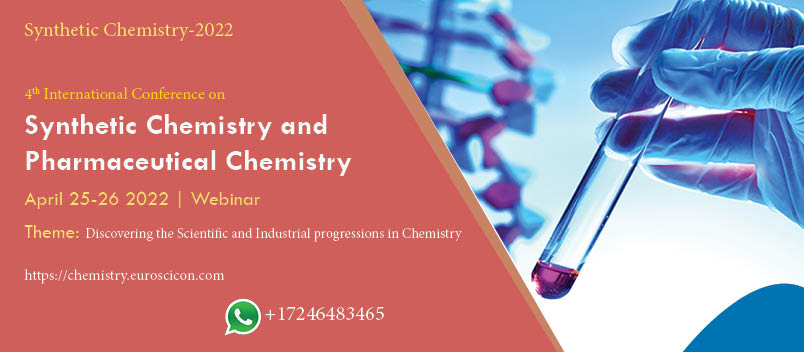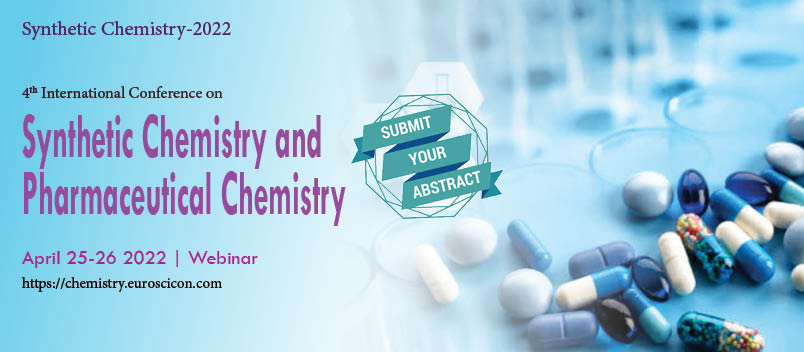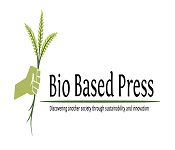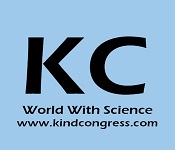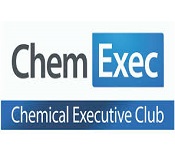Synthetic Chemistry-2022
ABOUT CONFERENCE
After successful completion of Chemistry 2020 & Chemistry 2021, the world’s leading 4th International Conference on Synthetic Chemistry and Pharmaceutical Chemistry which emphasized on the theme “Discovering the Scientific and Industrial progressions in Chemistry” and going to take place as Webinar from April 25-26, 2022.Organized by EuroSciCon. These Synthetic Chemistry Conferences are one of the most important events of the year. Synthetic Chemistry Conferences brings all the chemists and delegates together for great success. The Chemistry field assembles a broad range of scientific disciplines to discover, design, delivery, disposition of new drugs and therapies. The scope of these gatherings is extended by remarking key regulatory areas like Medicinal & Pharmaceutical Chemistry, Biochemical Chemistry, Green Chemistry, Physical and Theoretical Chemistry, Material Science and related branches in Chemistry. Giving an opportunity, EuroSciCon Chemistry Conferences have researchers, analysts, compound associations and all delegates of Pharmaceutical chemistry and organization divisions can grandstand their apt discoveries and in the meantime get presented to a valuable exhibit of research and most recent improvements. Chemistry Meetings are social event of a gathering of individuals to share their exploration thoughts and information of explicit strategies and points in the chemistry field. Much of the time there are in excess of a couple of speakers inside every gathering, and these speakers are specialists in chemistry fields. A few theme audits are modified every day all through the meeting, and members can typically settle on their selection of points from among these planned universal occasions.
What’s New?
Synthetic Chemistry Conferences includes international attendee workshops, lectures, and symposia, including a designated registration area, a refreshment break, and gala lunch. Synthetic Chemistry Conferences can join the EuroSciCon as an international member to receive discounts on registration. So come and join leading experts and allied professionals from April 25-26, 2022 to keep up with the rapidly accelerating pace of change that is already having an impact on the field of Chemistry and will continue to in the future. Chemistry Congress are social event of a gathering of individuals to share their examination thoughts and learning of explicit methods and subjects in the chemistry field as explicit meetings Chemistry Conferences, Chemistry Meetings, Chemistry Events, Worldwide Chemistry Conferences, Chemistry USA conference, Chemistry Europe Conference, Chemistry Middle East Conferences, Chemistry Asia Pacific Conference, Materials Chemistry Conference, Industrial Pharmacy Conferences, Clinical Chemistry Conferences, Mass Spectrometry, Euro Chemistry Conferences, Industrial Chemistry Conference, African Pharma Congress, Histochemistry, Cheminformatics Conferences, Pharmaceutical Chemistry conferences, Organic Chemistry conference, Stereochemistry Conferences, Chromatography Congress, Regulatory Affairs Conference, Analytical Techniques, Bioanalytical Techniques, Applied Chemistry Conferences, Nuclear Chemistry Conference, Clinical Pharmacy, Separation Techniques Conferences, Polymer Chemistry Conferences, Medicinal Chemistry Conferences
Target Audience for Synthetic Chemistry 2022
Eminent Scientists/ Research Professors in the field of Chemistry, Junior/Senior research fellows, Students, Directors of chemicals research companies, Chemical Engineers, Members of Chemistry associations and exhibitors from chemicals Industry/chemical Industries from all over the world are welcomed to attend our impressive conference.
Why attend our Conference
It promotes the positive contributions of Chemistry Education / Chemicals by:
- Featuring the material's helpful properties and its positive commitments to society for the duration of its life cycle.
- Giving society with educational information to help raise awareness and correct misconceptions.
- Linking with European and national institutions in policy matters to secure decisions based on accurate information.
- Collaborating chemicals and its related contribution to sustainable development, novelty, and quality of life
- Introducing in-depth studies and sharing experiences.
SESSIONS AND TRACKS
Track 1: Analytical & Bio analytical Chemistry:
Analytical chemistry is an efficient science study and uses instruments and procedures used to explicit, see, and measure matter. Fundamentally package, perceiving affirmation or appraisal may establish the whole examination or be joined with another procedure. Division pulls back analytics. Emotional examination sees analytics, while quantitative examination picks the numerical entire or fixation. Analytical science contains set up, wet creation systems and present day, instrumental strategies. Conventional emotional procedures use allocations, for example, precipitation, extraction, and refining. The expansive field of analytical and bio analytical chemistry covers the improvement of instruments for mass spectrometry, metalloids, Ionics, and the analytical portrayal of Nano-and biomaterials. Among these the energetic and bleeding edge field that gets wide research intrigue is bio analysis. The advanced fields in Analytical and Bio analytical Chemistry are instrumental improvements for analytical proteomics, imaging, advancement of scaled down gadgets, sensors, chemo metrics and examining techniques. Issues in pharmaceutical businesses are illuminated by the use of bio analytical procedures, making new advancements in biomedical field.
- Analytical Techniques for Clinical Chemistry
- Chemical Analysis
- Chromatographic & Electrophoretic
- Electrochemical Analysis
- Electrochemical Methods
- Equilibrium Chemistry
- Gravimetric Methods
- Separation Techniques
- Spectroscopic Methods
- Standardizing analytical Methods
- Titrimetric Methods
Track 2: Physical Chemistry and Theoretical Chemistry:
The utilization of physical standards and estimations to comprehend the properties of issue, just as for the advancement of new innovations for nature, vitality and drug is Physical Chemistry. Progressed Physical Chemistry subjects comprise of various spectroscopic techniques going from ultrafast and mass spectroscopy, atomic attractive and electron paramagnetic reverberation, x-beam ingestion and nuclear power microscopy, additionally hypothetical and computational tools. These devices give nuclear dimension comprehension to applications; for example, bury facial chemistry of catalysis and inserts, electron and proton exchange, protein work, photosynthesis, Nano devices for bio-identification and receptors. The hole between the hypotheses and strategies of cutting edge material science and concoction frameworks is filled by Physical chemistry. Physical and hypothetical scientific experts work to unwind the wonders that oversee all parts of the physical world by utilizing propelled portrayal and computational techniques. Propelled portrayal strategies is connected to an assorted scope of points – vitality stockpiling materials for electric vehicles, organically applicable proteins to comprehend degenerative ailments, photograph instigated sub-atomic changes and complex surface properties by Physical scientists. As to improve our comprehension of all parts of chemistry, directly down to the idea of compound holding, Theoretical scientific experts work to build up quantum mechanical strategies.
- Chemical Kinetics
- Chemical thermodynamics
- Homogeneous and heterogeneous catalysis
- Petroleum chemistry
- Physical chemistry: a molecular approach
- Quantum Mechanics in Chemistry
- Solid-state chemistry
- Statistical Mechanics
- Surface science
Track 3: Polymer Chemistry:
Polymer Chemistry is so inescapable and pertinent self-restraint in the contemporary circumstance that it is unnecessary to spend a lot of words to accentuate its job. In actuality, it has been proposed to assign our time as the polymer age, to stamp its enormous contrast from going before humanity times commanded by method for an arrangement of different materials (the stone, the bronze, the iron ages) and to comment that our way of life would be scarcely ever useful other than polymers. The approach and the world scale foundation of the polymer innovation have formed our general surroundings and have significantly changed its points of view, as it occurs for any progressive innovation. In spite of the inconceivable accomplishments we have seen close by the years, many energizing difficulties stay to
Market Analysis
The chemicals market consists of speciality chemicals, commodity chemicals, agricultural chemicals, and other chemicals (which includes products such as pharmaceutical chemicals).
Market values are taken at producer selling price (PSP).
The global chemicals market is expected to generate total revenues of $4,378.7bn in 2016, representing a compound annual growth rate (CAGR) of 3.9% between 2012 and 2016.
The performance of the market is forecast to follow a similar pattern with an anticipated CAGR of 3.8% for the five-year period 2016 - 2021
Global Chemicals industry profile provides top-line qualitative and quantitative summary information including: market size (value 2012-16, and forecast to 2021). The profile also contains descriptions of the leading players including key financial metrics and analysis of competitive pressures within the market.
Essential resource for top-line data and analysis covering the global chemicals market. Includes market size and segmentation data, textual and graphical analysis of market growth trends and leading companies.
- The chemicals market consists of speciality chemicals, commodity chemicals, agricultural chemicals, and other chemicals (which includes products such as pharmaceutical chemicals). Market values are taken at producer selling price (PSP). Any currency conversions used in the creation of this report have been calculated using constant 2015 annual average exchange rates.
- The global chemicals market is expected to generate total revenues of $4,378.7bn in 2016, representing a compound annual growth rate (CAGR) of 3.9% between 2012 and 2016.
- Commodity chemicals dominate the global market. The prevalence of commodity chemical production is common across the globe as they are typically low-cost and low-skill to produce, however increasing technology and chemical expertise fuelled by increasing investment has resulted in the sustained growth of specialty chemicals
- The performance of the market is forecast to follow a similar pattern with an anticipated CAGR of 3.8% for the five-year period 2016 - 2021
- Save time carrying out entry-level research by identifying the size, growth, major segments, and leading players in the global chemicals market
- Use the Five Forces analysis to determine the competitive intensity and therefore attractiveness of the global chemicals market
- Leading company profiles reveal details of key chemicals market players' global operations and financial performance
- Add weight to presentations and pitches by understanding the future growth prospects of the global chemicals market with five year forecasts
Benefits of Attending
Benefits of Attending
Participants can acquire direct admittance to experts and chiefs and can build perceivability through marking and systems administration at the gathering.
Learn and talk about key news and difficulties with senior level speakers.
With introductions, board conversations, roundtable conversations, and workshops, we cover each point start to finish, from worldwide large scale issues to techniques to strategic issues.
Discuss quality activities that can be applied in the training.
Discuss approaches to work together in setting up quality activities all through the Synthetic Chemistry and Pharmaceutical Chemistry.
Exchange thoughts and organization with driving Surgeons, Physicians, Doctors, Nurses, Health policymakers, Health experts, Engineers, Researchers from in excess of 40 nations.
Get affirmed for your interest.
Knock Down Geographical Barriers.
Great asset for acquiring new vocation abilities.
Learn from the Pros.
Global openness to your examination.
Examination Contribution and Achievement
Expert Level (Scientific Service Achievement Award)
Professional Level (The Research Contribution Award)
Scholar Level (The Upcoming Researcher Award)
Women Scientist (The Women of Science Award)
Outstanding speaker in Synthetic Chemistry 2022
Best Keynote Speaker in Synthetic Chemistry 2022
Best Poster Presentation in Synthetic Chemistry 2022
Outstanding Masters/Ph.D./Post Doctorate thesis work Presentation in Synthetic Chemistry 2022
